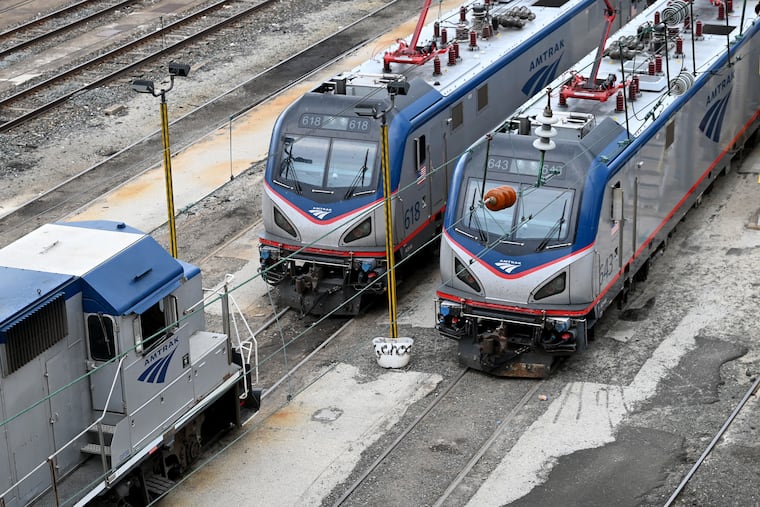Amtrak’s new bus service links Reading and Pottstown to Philly. Is it a precursor to rail service?
The new bus service is viewed by hopeful advocates in Berks, Chester and Montgomery Counties as a step toward reviving passenger train service.

Amtrak started a new express bus service this week linking Reading and Pottstown to Philadelphia and the rest of its national passenger rail network, offering two round-trips daily to 30th Street Station.
It’s seen as a step toward the long-sought revival of passenger rail service between Reading and Philadelphia, 41 years after the trains stopped running.
Passengers can book a ride on Amtrak’s Thruway bus service as a leg on a train trip continuing from Philadelphia. But getting a train ticket is not required. Riders can take the bus to the city and catch SEPTA Regional Rail trains, the Market-Frankford Line subway, or buses in and around 30th Street Station.
“This is huge,” said Gregory Downing, executive director of the South Central Transit Authority, which runs the public bus systems in Berks and Lancaster Counties.
“Our customers in Berks are ready and eager to have this open access to Philadelphia, for health care, for better opportunities, for visiting, and travel on Amtrak,” Downing said. “Providing more opportunity to people, that’s what we’re here for in transit.”
The railroad expects a boost in travel, officials said, especially on the Northeast Corridor to destinations such as Washington and New York.
For the region, many leaders hope the express bus service builds interest and support around an effort to link the cities by passenger rail.
“I hope it is an impetus,” Downing said. Establishing the Thruway route “tells you Amtrak thinks it’s well worth it. There’s a demand.”
The new service debuted a few weeks after Berks, Montgomery, and Chester Counties formed the Schuylkill River Passenger Rail Authority to work on reestablishing train service between Philadelphia and Reading, Pottstown, Phoenixville, and other stops.
That project is part of Amtrak’s strategic plan to add as many as 38 new rail routes by 2035. The federal infrastructure act contains $66 billion for Amtrak, including money to restore discontinued routes and begin serving new destinations.
Setting up an authority shows the counties’ commitment to the project and will help in the competition for federal and state money to help fund it, officials said. The authority also will be the point of contact for negotiations with Norfolk Southern, the private freight railroad that owns the track on the Schuylkill corridor, as well as possible operators, like Amtrak.
Reading had a rail connection with Philadelphia for a century, but the last train rolled into town in June 1981. SEPTA was then running the service and was in the process of switching its fleet to electric power. Diesel locomotives were used on the route because tracks between Norristown and Reading are not electrified.
By 2030, a Reading-to-Philadelphia train line would draw about 2,300 daily riders during the workweek for service that required a transfer in Norristown, PennDot projected in a December 2020 analysis. If passengers did not have to change trains, it could draw 6,400 daily passengers, planners estimated.
“For single-seat service, the corridor would either need to be electrified from Norristown to Reading or dual-power locomotives would need to be used,” the report said. Those locomotives would cost about $145 million, and it’s not clear whether they could meet weight restrictions on SEPTA’s network, it said.
Other challenges include the likely need for infrastructure work on the line and Norfolk Southern’s willingness to accommodate passenger service.
Past studies went nowhere, but civic and business leaders think the time is right given climate change, high gasoline prices, congested traffic on highways between the two cities — and the jolt of fresh federal infrastructure money.
Amtrak uses Thruway service around the country to connect sizable towns and popular destinations to cities where its trains stop. For example, buses link Longview, Texas, with a population a little above 81,000, to Shreveport, La., and Houston. Last month, 100,000 customers used the service, Amtrak said.
The fare for the new Thruway bus in Pennsylvania is $9 one way from Pottstown and $14 one way from Reading, Amtrak said, with a free transfer to SEPTA’s Suburban and Jefferson Stations in Center City.
Eastbound, the bus is scheduled to depart Reading at 7 a.m. and Pottstown at 7:30 a.m., arriving at Market and 30th Streets at 8:55 a.m. Another leaves Reading at 2 p.m. and Pottstown at 2:30 p.m. and reaches Philadelphia at 3:55 p.m.
Westbound, the bus is scheduled to leave 30th Street at 11:35 a.m. and arrive at 12:50 p.m. in Pottstown and 1:20 p.m. in Reading. Another departs Philadelphia at 5:55 p.m. and is scheduled to arrive at 7:10 p.m. in Pottstown and in Reading at 7:40 p.m.